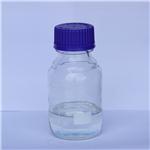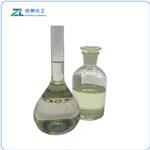Triisobutyl phosphate
- CAS No.
- 126-71-6
- Chemical Name:
- Triisobutyl phosphate
- Synonyms
- TIBP;isobutylphosphate;Triisobutylphosphat;TRIISOBUTYL PHOSPHATE;TRIS-ISOBUTYLPHOSPHATE;Triisobutyl Phosphate (TiBP);Tris(2-methylpropyl) phosphate;99% purity Triisobutyl phosphate;PHOSPHORIC ACID TRIISOBUTYL ESTER;Triisobutylphosphate in isooctane
- CBNumber:
- CB8174190
- Molecular Formula:
- C12H27O4P
- Molecular Weight:
- 266.31
- MDL Number:
- MFCD00039849
- MOL File:
- 126-71-6.mol
- MSDS File:
- SDS
| Melting point | <-60°C |
|---|---|
| Boiling point | ~205 °C(lit.) |
| Density | 0.965 g/mL at 20 °C(lit.) |
| vapor pressure | 0.002 hPa (20 °C) |
| refractive index |
n |
| Flash point | 150 °C |
| storage temp. | Store below +30°C. |
| solubility | 0.26g/l |
| form | Oil |
| color | Colourless |
| Water Solubility | 264mg/L at 25℃ |
| InChI | InChI=1S/C12H27O4P/c1-10(2)7-14-17(13,15-8-11(3)4)16-9-12(5)6/h10-12H,7-9H2,1-6H3 |
| InChIKey | HRKAMJBPFPHCSD-UHFFFAOYSA-N |
| SMILES | P(OCC(C)C)(OCC(C)C)(OCC(C)C)=O |
| LogP | 3.72 at 25℃ |
| CAS DataBase Reference | 126-71-6(CAS DataBase Reference) |
| FDA UNII | 6MKE1AR3GB |
| EPA Substance Registry System | Triisobutyl phosphate (126-71-6) |
| UNSPSC Code | 12352108 |
| NACRES | NA.22 |
SAFETY
Risk and Safety Statements
| Symbol(GHS) |  GHS07 |
|||||||||
|---|---|---|---|---|---|---|---|---|---|---|
| Signal word | Warning | |||||||||
| Hazard statements | H317 | |||||||||
| Precautionary statements | P261-P272-P280-P302+P352-P333+P313-P362+P364 | |||||||||
| Hazard Codes | Xi | |||||||||
| Risk Statements | 43 | |||||||||
| Safety Statements | 36/37 | |||||||||
| WGK Germany | 1 | |||||||||
| RTECS | TC9300000 | |||||||||
| Autoignition Temperature | 430 °C DIN 51794 | |||||||||
| HS Code | 2919 90 00 | |||||||||
| Toxicity | LD50 orally in Rabbit: > 5000 mg/kg LD50 dermal Rabbit > 5000 mg/kg | |||||||||
| NFPA 704 |
|
Triisobutyl phosphate price More Price(23)
| Manufacturer | Product number | Product description | CAS number | Packaging | Price | Updated | Buy |
|---|---|---|---|---|---|---|---|
| Sigma-Aldrich | 8.18606 | Triisobutyl phosphate for synthesis | 126-71-6 | 100mL | $42.3 | 2024-03-01 | Buy |
| Sigma-Aldrich | 8.18606 | Triisobutyl phosphate for synthesis | 126-71-6 | 1L | $98 | 2024-03-01 | Buy |
| Sigma-Aldrich | 8.18606 | Triisobutyl phosphate for synthesis | 126-71-6 | 500mL | $66.1 | 2023-06-20 | Buy |
| TRC | P359475 | PhosphoricAcidTris(2-methylpropyl)Ester | 126-71-6 | 2.5g | $155 | 2021-12-16 | Buy |
| American Custom Chemicals Corporation | SDY0000504 | TRIISOBUTYL PHOSPHATE 95.00% | 126-71-6 | 1G | $148.05 | 2021-12-16 | Buy |
Triisobutyl phosphate Chemical Properties,Uses,Production
Description
Triisobutyl phosphate (TIBP) is a very strong polar solvent, sometimes known as Phosphoric acid triisobutyl ester. It is primarily used as an admixture for liquefying concrete, paper coating systems, and textile auxiliaries. It is mainly used as an antifoaming agent in various aqueous systems, where it can destroy foam and act as a foam inhibitor. TiBP is also used to introduce solutions for synthetic resins and natural rubber. In both ellulose-based plastics and synthetic resins, it is used as a flame-retarding plasticizer. TiBP is employed as a pasting agent for pigment pastes. Due to the limited influence of temperature on the viscosity of TiBP, it also serves as an important component in the manufacture of hydraulic fluids for aircraft. As a very strong wetting agent, TiBP is used in the textile industry and the field of adhesives.
Uses
Phosphate esters are used as flame retardants, plasticizers,
hydraulic fluids, solvents, extraction agents, antifoam agents,
Partition behavior in water, sediment, and soil
Phosphate ester flame retardants enter the environment from
industrial sources and disposal of consumer products containing
flame retardants. These anthropogenic compounds
have been detected in water, soil, and air owing to widespread
use following their fast emergence and popularization during
1970s. Occurrence of these phosphate ester flame retardants is
widespread in surface water and groundwater because of the
leaching of PVC plastics and polyurethane foams, effluent from
industrial sources, and spills of hydraulic fluids. This primary
contaminated water is then transported to a secondary source,
such as drinking water. Hydrolysis, although slow because of
poor solubility and pH dependence, is the most important
abiotic elimination process. In soil and sediment, phosphate
ester flame retardants are persistent because they have the
tendency to adsorb strongly. Volatilization and biodegradation
are potential elimination processes for phosphate esters
adsorbed to soil.
Environmental persistency (degradation/speciation)
These retardants can change chemical composition in the
environment. Generally, most phosphate esters are poorly
soluble in water and adsorb strongly to soils. These compounds
are considered emerging pollutants because of their prevalence
and persistence in the environment. Particulate-phase phosphate
esters are subject to wet and dry deposition, whereas
semi-volatile phosphate esters have the potential to hydrolyze
to diesters, monoesters, and phosphoric acid. There is no
information available that suggests that selected phosphate
ester flame retardants undergo transformation or degradation
in the atmosphere.
Long-range transport
This is highly dependent on the specific compound.
Bioaccumulation and biomagnification
Phosphate esters are subject to biodegradation in aquatic and
terrestrial environments.
Uses
Phosphoric Acid Tris(2-?methylpropyl) Ester is found in the groundwater downgradient of a landfill (Grindsted, Denmark). It is also a flame retardant and plasticizer.
Definition
ChEBI: Tri-isobutylphosphate is a trialkyl phosphate.
Flammability and Explosibility
Not classified
Environmental Fate
Routes and pathways relevant physicochemical properties
(e.g., solubility, Pow, Henry constant.)consumer and industrial items and play an important role in
safeguarding life and property. A large and diverse group of
anthropogenic compounds constitute flame retardants, which
are added to combustible materials to render them more
resistant to ignition. They are designed to minimize the risk of
a fire in the event of contact with a small heat source such as
a cigarette. A wide range of different flame retardants is
produced, because many materials and products that are to be
rendered fire safe are very different in nature and composition.
Therefore, having variety in flame retardant products is necessary
so as to retain key material functionality. For example,
plastics have a wide range of mechanical and chemical properties
and differ in combustion behavior. These materials in
particular are the main focus of phosphate ester flame
retardants.
Phosphate esters are derivatives of tri protic acid, phosphoric
acid, with a general formula of RxH3°xPO4. Flame retardants are
composed of a group of chemicals with similar properties but
slightly different structures. They are typically liquids and some
are solids at room temperature. Some examples of the phosphate
ester flame retardants include: tris(2-chloroethyl)phosphate
(TCEP), tributyl phosphate (TnBP), tris(2-butoxyethyl)
phosphate (TBEP), tris(1,3-dichloro-2-propyl) phosphate
(TDCP), triphenyl phosphate (TPP), tris(2-chloro-isopropyl)
phosphate (TCPP), and triisobutyl phosphate (TiBP). These
compounds are trisubstituted and categorized as alkyl (TnBP,
TiBP), alkyl ether (TBEP), chloroalkyl (TCEP, TCPP, TDCP),
and aryl (TPP) phosphate esters.
Purification Methods
Purify it by repeated crystallisation, from hexane, of its addition compound with uranyl nitrate. (see tributyl phosphate.) [Siddall J Am Chem Soc 81 4176 1959; see Cherbuliez in Organo Phosphorus Compounds (Kosolapoff & Maier eds) Wiley Vol 6 pp 211-577 1973.]
Toxics Screening Level
The initial threshold screening level (ITSL) for triisobutyl phosphate (CAS# 126-71-6] is 22 μg/m3 based on an 8-hour averaging time. This memo describes the basis and derivation of the ITSL.
Triisobutyl phosphate Preparation Products And Raw materials
| Supplier | Tel | Country | ProdList | Advantage | |
|---|---|---|---|---|---|
| Zhangjiagang Xinya Chemical Co., Ltd. | +86-0512-58980899 +86-13915696858 | sales@zjgxinyachem.com | China | 44 | 58 |
| ChemFine International Co.,Ltd. | +86-510-82753588 +86-13806194144 | info@chemfineinternational.com | China | 300 | 58 |
| Jinan Finer Chemical Co., Ltd | +86-531-88989536 +86-15508631887 | sales@finerchem.com | China | 2956 | 58 |
| Hebei Chuanghai Biotechnology Co., Ltd | +86-15531157085 +86-15531157085 | abby@chuanghaibio.com | China | 8808 | 58 |
| Hebei Chuanghai Biotechnology Co,.LTD | +86-13131129325 | sales1@chuanghaibio.com | China | 5870 | 58 |
| Hebei Chuanghai Biotechnology Co., Ltd | +8615531151365 | mina@chuanghaibio.com | China | 18137 | 58 |
| Hebei Kingfiner Technology Development Co.Ltd | +86-15532196582 +86-15373005021 | lisa@kingfinertech.com | China | 3007 | 58 |
| Henan Fengda Chemical Co., Ltd | +86-371-86557731 +86-13613820652 | info@fdachem.com | China | 20238 | 58 |
| Shaanxi TNJONE Pharmaceutical Co., Ltd | +86-17396673057 | linda@tnjone.com | China | 1143 | 58 |
| Hebei Zhuanglai Chemical Trading Co.,Ltd | +8613343047651 | admin@zlchemi.com | China | 3692 | 58 |
View Lastest Price from Triisobutyl phosphate manufacturers
| Image | Update time | Product | Price | Min. Order | Purity | Supply Ability | Manufacturer | |
|---|---|---|---|---|---|---|---|---|
 |
2025-04-15 | Triisobutyl phosphate
126-71-6
|
US $2.00 / KG | 1KG | 99% | 1000mt/year | Jinan Finer Chemical Co., Ltd | |
 |
2025-04-15 | Triisobutyl phosphate
126-71-6
|
US $0.00-0.00 / KG | 1KG | 99% | 500000kg | Hebei Chuanghai Biotechnology Co., Ltd | |
 |
2025-04-15 | PHOSPHORIC ACID TRIISOBUTYL ESTER
126-71-6
|
US $70.00 / kg | 1kg | 99 | 5000 | Hebei Zhuanglai Chemical Trading Co.,Ltd |
-

- Triisobutyl phosphate
126-71-6
- US $2.00 / KG
- 99%
- Jinan Finer Chemical Co., Ltd
-

- Triisobutyl phosphate
126-71-6
- US $0.00-0.00 / KG
- 99%
- Hebei Chuanghai Biotechnology Co., Ltd
-

- PHOSPHORIC ACID TRIISOBUTYL ESTER
126-71-6
- US $70.00 / kg
- 99
- Hebei Zhuanglai Chemical Trading Co.,Ltd








